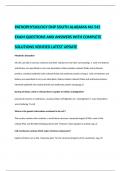Exam (elaborations)
PATHOPHYSIOLOGY DNP SOUTH ALABAMA NU 545 EXAM QUESTIONS AND ANSWERS WITH COMPLETE SOLUTIONS VERIFIED LATEST UPDATE
PATHOPHYSIOLOGY DNP SOUTH ALABAMA NU 545 EXAM QUESTIONS AND ANSWERS WITH COMPLETE SOLUTIONS VERIFIED LATEST UPDATE
Metabolic absorption
All cells can take in and use nutrients and other substances from their surroundings. 1. Cells of intestines and kidneys are specialized to carry out absorption....
[Show more]
Preview 4 out of 34 pages
Uploaded on
October 10, 2024
Number of pages
34
Written in
2024/2025
Type
Exam (elaborations)
Contains
Questions & answers
All documents for this subject (26)
PATHOPHYSIOLOGY DNP SOUTH ALABAMA NU 545




